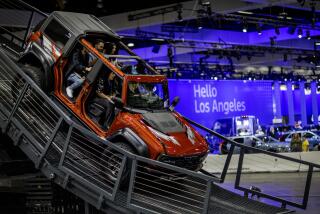High-Octane Auto Shows : Attendance Is Up as America Rediscovers an Old Love Affair
- Share via
If cars are America’s passion, auto shows are its orgies.
Hundreds of gleaming new cars are assembled in one place to be ogled and caressed. Sit behind the wheel of a $35,000 Corvette. Glide a hand along the smooth lines of a $100,000 Ferrari.
And, because most shows prohibit direct selling, it can be done without pressure from those ubiquitous salesmen who make browsing difficult in dealer showrooms.
Auto shows are enjoying a resurgence as Americans rediscover their enchantment with the automobile and move away from generic boxes on wheels. Attendance is up at most big national shows, and regional shows are sprouting up all over.
On Saturday alone, shows opened in seven cities: Los Angeles, Detroit and Philadelphia are classed as national shows; Baltimore, Omaha, Syracuse and Toledo are regionals.
“The demand has increased and the number of shows is growing fast in response,” said A. L. Longoria, who recently retired after 40 years with Ford but still helps stage auto shows on the West Coast.
Popular Regional Shows
Attendance at the Los Angeles auto show, running through Jan. 15 at the Convention Center downtown, is expected to top the half-million mark for the first time. The nation’s largest show, at Chicago’s cavernous McCormick Place, may exceed the million mark in visitors for the first time in February.
With more annual new-car registrations than any other state, California is home to increasingly popular regional shows.
The 4-year-old Long Beach show drew 107,000 at the end of November. More than 175,000 are expected at the once-dormant Orange County show Feb. 18-26 at Anaheim Stadium. San Diego’s 4-year-old show, running March 1-5 at the San Diego Convention Center, is expected to attract more than 60,000, and plans call for nearly tripling its space next year.
And, in a symbolic move, the Detroit auto show has nearly doubled its previous space and added a new format aimed at capturing the innovative flair of the Tokyo and European shows by bringing in top automotive executives and the international press corps.
“What we’re trying to do is reintroduce Detroit to the world as the center of the car business,” said Patrick J. Fitzgerald of the Detroit show, which even has a new name--the North American International Auto Show.
Major international shows, such as those in Frankfurt, Tokyo and Paris, are face-offs where the world’s auto manufacturers unveil new models and strut the latest technology and top executives discuss plans.
American auto shows are far more sales-oriented, even though no cars are sold directly at the shows. To be sure, the big shows have futuristic “concept cars” and custom vehicles to bring in the car buffs. But the real purpose is to provide, under one roof, a look at the latest models available from Ford, General Motors, Chrysler, Toyota, Jaguar, Volkswagen, Honda and every other major car line.
Eclectic Tastes
“Whatever your automotive taste is, we have got it,” said Benjamin R. Orloff, general manager of the Los Angeles show. “We have over 650 cars and trucks. Every production car merchandised in Southern California is on display.”
At the giant Chicago show, nearly 1,000 cars and trucks will jam 680,000 square feet covering two floors. More space is available in a nearby building, but show manager Jerry H. Cizek said he does not want to get so big that people cannot see every exhibit.
“This is not like a trade show where people go to see a specific item,” said Cizek. “It’s entertainment, and people go to see the whole thing.”
The Long Beach and Orange County shows emphasize sales by eschewing concept cars and custom vehicles to keep the focus on available new cars.
As the car shows grow in popularity, so does competition between exhibitions. Detroit is striving--probably without hope--to unseat Chicago as king of the shows. Regional shows compete for larger attendance and exhibits of more lines of cars among themselves and with the national displays.
Since they are all designed to sell cars and most are sponsored by associations of new car dealers, the rivalry amounts more to one-upmanship than outright battling. Virtually all show organizers give away substantial numbers of show tickets, then accuse competitors of “papering” their houses with freebies.
To attract attendance and prestige, shows vie to host premieres of new models and the latest concept cars. Both Los Angeles and Detroit, for instance, boast the first public looks at the new Lexus and Infiniti luxury lines from Japan, Audi’s first V-8 and three new Porsches this week.
Yet Orloff maintains that there is no real competition, saying: “Why should there be a rivalry? The purpose of an auto show is to spotlight the products of the manufacturers.” In the next breath, he adds: “We’re a world-class spectacular. We don’t take a back seat to anybody.”






